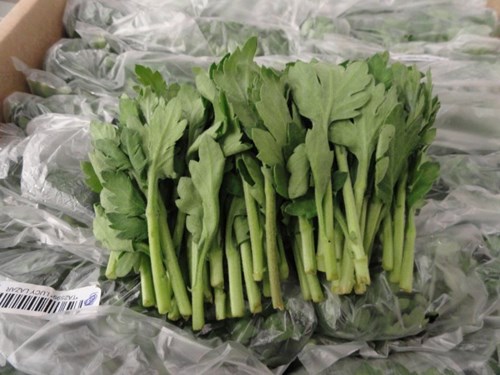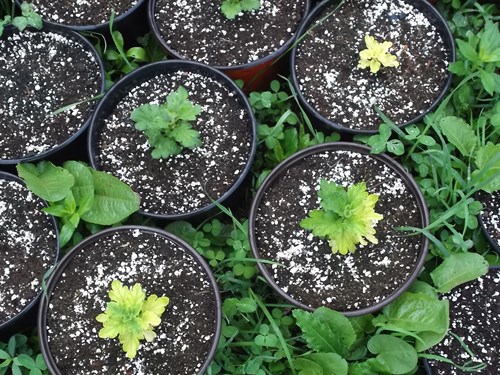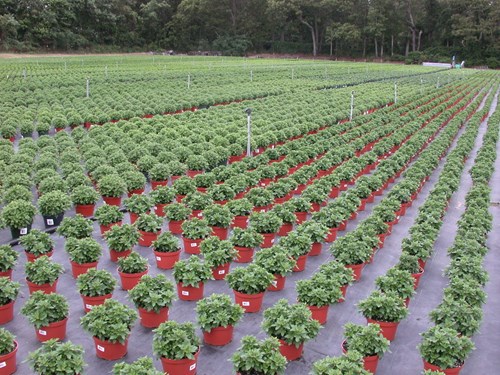Tips on Fertilizing Mums with Water Soluble Fertilizer


Have you ever considered how much food a person eats from an infant to a mature adult? Babies and young children eat very little food. As they enter their teen years, food consumption greatly increases as their growth and development are most rapid. Then as adults, food consumption decreases (or should decrease) as the growth rate has greatly slowed.
This same thinking can be applied to fertilizer application rates with mums. Young plants and flowering mums require lower fertilizer application rates (due to slower growth rates), while mums that are actively growing require higher fertilizer application rates.
Why Use Water Soluble vs. Controlled Release Fertilizer?
When it comes to fertilizing mums, the most common ways of delivering fertilizer are through the application of water-soluble fertilizer when irrigating or the incorporation of controlled-release fertilizer into the growing medium.
Both have advantages and disadvantages as seen in Table 1. A major advantage of using water-soluble fertilizer is that you can control and adjust the application rates to provide for the changing needs of a mum crop. This is more difficult to do with controlled-release fertilizers.
| Water Soluble Fertilizer | Controlled Release Fertilizer | |
|---|---|---|
| Advantages |
|
|
| Disadvantages |
|
|
Fertilizer Selection
The first step in selecting the proper water-soluble fertilizer(s) is to have your water tested. First, to minimize pH fluctuations in the growing medium during crop production, it is best to match the alkalinity of the water to the potential acidity/basicity of the fertilizer. Next, look at the elements the water is providing or possibly not providing as in the case of calcium, magnesium and sulfate.
Ideally, mums need 40-120 ppm calcium, 30-60 ppm magnesium and 25-75 ppm sulfur (75-250 ppm sulfate) on a constant basis. If your water is lacking in these elements, verify they are provided by the fertilizer as most do not provide significant levels of these three elements.
Often, Epsom salt (magnesium sulfate) is mixed in the stock solution of a water-soluble fertilizer to provide magnesium and sulfate. For calcium, a second calcium-containing fertilizer is often applied and rotated with a primary fertilizer. The reason is most calcium-based fertilizers are potentially basic, meaning they will cause the pH of the growing medium to rise over time. Therefore, a primary fertilizer that is potentially acidic is used to help maintain proper growing medium pH.
Rooting/Young Plants
The main goal when rooting mum cuttings is to avoid nutrient deficiencies as this can compromise plant growth and bud formation as well as reduce branching. Also, it is important to keep cuttings from wilting due to lack of water as this too can reduce overall growth and branching. It has been recommended that fertilization begin 3 days after sticking at a rate of 100-150 ppm nitrogen, 2-3 times per week.
If cuttings are stuck into a growing medium without starter fertilizer, then start fertilization at the time of sticking. The electrical conductivity (E.C.) of the growing medium should be 1.0-2.0 mmhos/cm (saturated media extract or SME) and pH should be between 5.5-6.2.

Active Growth/Vegetative Stage
After rooted cuttings/liners have been transplanted into their final containers, they will begin a rapid growth phase. Faster growth rates require higher fertilizer application rates, so water-soluble fertilizer application rates should be increased to a constant feed rate of 200-300 ppm nitrogen. It is not unusual for some cultivars to show iron deficiency symptoms (yellow new leaves with green veins) during this phase.
This is typically a problem in more vigorous cultivars as well as yellow and white flowering varieties. Growers often correct this by increasing fertilizer application rates, but it is better to apply a one-time application of an iron chelate, such as iron-EEDHA.

The E.C. of the growing medium should be maintained at 1.5-3.0 mmhos/cm (SME) and the pH should be between 5.6-6.2. If E.C. exceeds 3.5-4.0, it is best to leach with a low-rate, water-soluble fertilizer. Soluble salts can build up in the growing medium if fertilizer application rates are too high or the fertilizer stock solution is mixed improperly. If E.C. drops below 1.5 mmhos, then application rates may be too low, fertilizer stock solution was mixed improperly or rain leached the fertilizer from the growing medium.
Maintain a constant feed rate of 200-300 ppm nitrogen so that mums can grow to the proper size before flower initiation. If any nutrient deficiencies occur during this growth phase, they should be corrected as fertilizer application rates should be reduced once flower initiation begins. With reduced rates, there is less fertilizer available in the growing medium to address nutrient deficiencies.

Flowering Stage
Once flower initiation begins, the growth rate of mums slows. The fertilizer application rate should be reduced to 75-125 ppm nitrogen on a constant feed basis and provided until mums are sold. The E.C. should be maintained at 1.0-2.0 mmhos/cm (SME). If the fertilizer application rate is not reduced, fertilizer salts can quickly build up in the growing medium. Excess salts can burn mum roots, allowing for Pythium aphanidermatum or other fungal pathogens to infect the root system, causing plant loss.
Low Rate, High Micronutrient Feeding
Recently, a new concept in fertilizing mums has been used with some success. Essentially, growers feed their mums at a constant feed rate of 100-150 ppm nitrogen throughout the crop cycle without compromising plant growth or finishing size. The key to doing this is to make sure there is sufficient calcium, magnesium and sulfate at every fertilizer application (as discussed above) as well as sufficient micronutrients.
Iron rates should be 1-2 ppm at every watering along with acceptable levels of other micronutrients. Most fertilizers will not provide enough micronutrients at a feed rate of 100-150 ppm nitrogen, so additional micronutrients will need to be added. Although growers have been successful with this program, there is more potential for nutrient deficiencies to show up and more individual fertilizers must be applied. If this program is being considered, it is best to do a trial on a small number of plants and verify it will work for you.
Mums are great fall crops that are easy to grow as long as they are fertilized at proper rates. For more information on selecting fertilizers based on water quality or the proper PRO-MIX growing medium to use for mums, please consult our website at pthorticulture.com.
References:
- Garden Mums – Past Crop Problems and Production Tips ag.umass.edu/print/9414
- 2016 Garden Mum Culture Guide. Syngenta Flowers. syngentaflowers-us.com/sites/g/files/kgtney846/files/file_field/import/field_media_link/sites/g/files/zhg721/f/garden_mum_culture_guide_lr_web.pdf